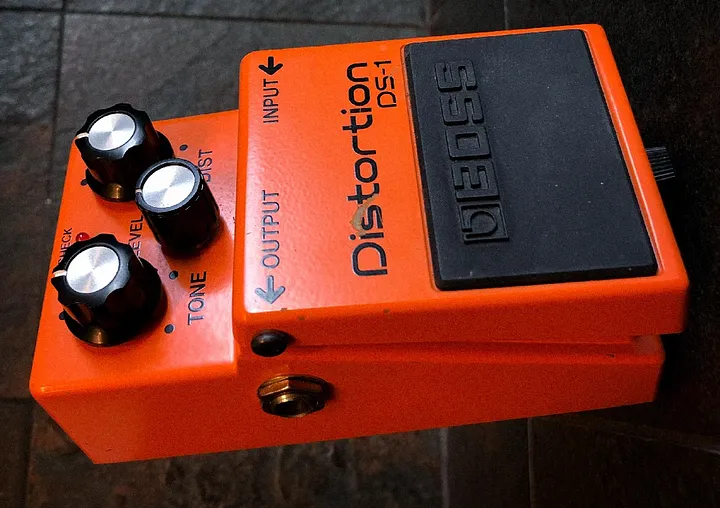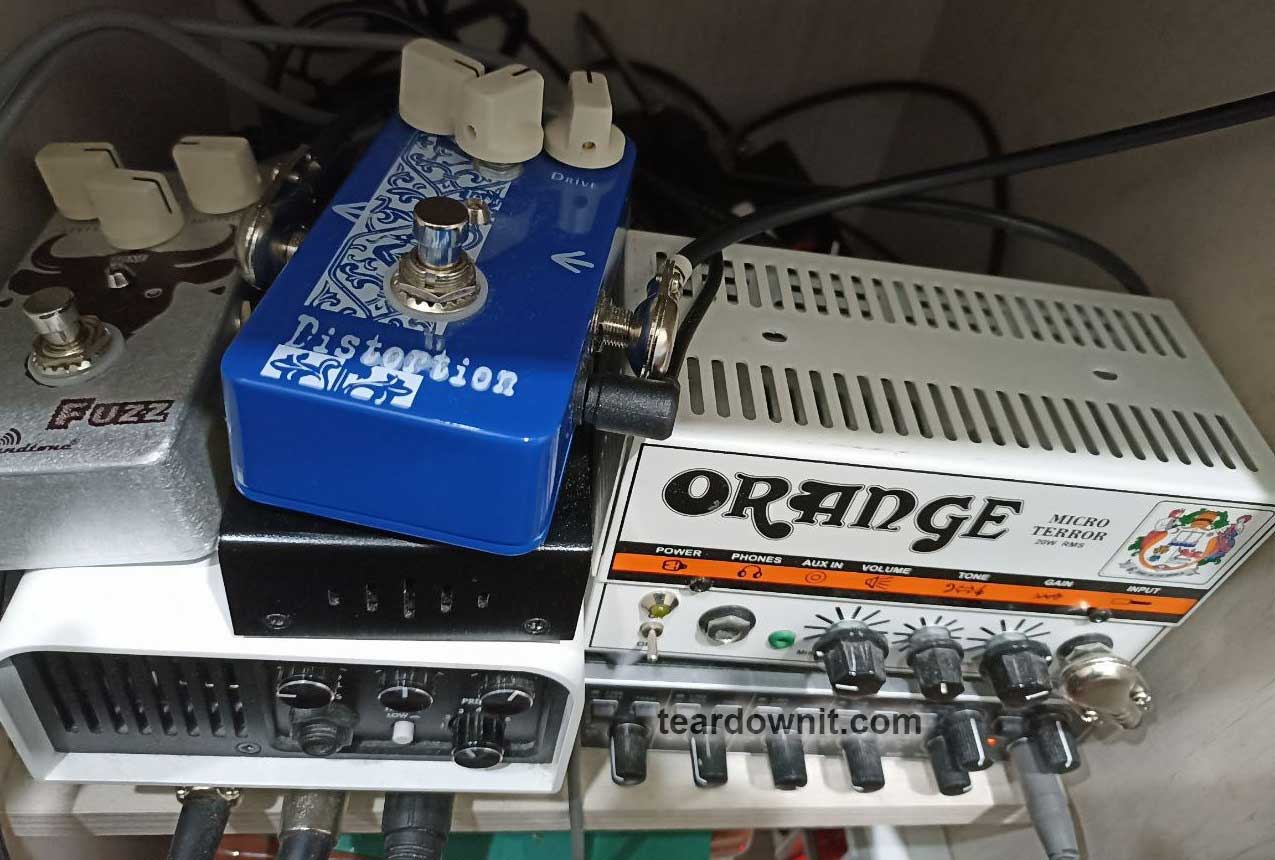Many guitarists consider the DS-1 to be the worst-sounding guitar pedal. Could this 1978 Roland design be a failure and is now hopelessly outdated?
 However, the idol of millions, Kurt Cobain, the author of world-favorite solos John Frusciante, and electric guitar classics Steve Vai and Joe Satriani either did not know that the BOSS DS-1 sounds terrible or managed to make it sound good.
However, the idol of millions, Kurt Cobain, the author of world-favorite solos John Frusciante, and electric guitar classics Steve Vai and Joe Satriani either did not know that the BOSS DS-1 sounds terrible or managed to make it sound good.

We can get a good sound out of this classic pedal, too. For that, we'll put it, listen to it, and start by studying the circuitry.

Like most other guitar pedals, it is powered by a 9-volt battery. In the case of overdrive and distortion pedals, this battery not only gives you independence from the power supply but, oddly enough, also plays a part in shaping the sound.

Lovers of vintage pedals also prefer vintage, saline-type batteries. The fact is that the Leclanche manganese-zinc cell has not only less capacity and durability but also a higher internal resistance than the more modern alkaline cell.
The high internal resistance of a battery is usually a bad thing. But in the case of guitar amplification, the drawdown of the supply voltage due to the current consumption changes the character of the sound for the better.
After all, the task of a guitar circuit - pedals, amplifier, cabinet with speakers, as opposed to hi-fi equipment - is not to accurately reproduce the input signal but to distort it beautifully. Beautiful, i.e., softened, which is achieved by power sagging.

Mesa Boogie is the world leader in amplifying heavy, overdriven guitar styles. It equipped its flagship product, the Triple Rectifier head, with a rectifier switch: tube and solid-state.
And for the creators and buyers of the amplifier, it was so important that the word Rectifier became the central part of its name! The fact is that different rectifiers have different load characteristics, so they limit the output signal in different ways. And it is necessary to soften it. Otherwise, you will get unpleasant to the ear "sand".

And the miniature, all-semiconductor Spirit of Metal by Hughes & Kettner has not a rectifier switch but an entire SAGGING knob that adjusts to simulate the load response of the power supply.

This adjustment proved so crucial for designers and musicians that one of only four knobs on the front panel was dedicated to it. A second tone knob could have been made, such as an ultra-low resonance or an ultra-high frequency preset, like the Peavey 6505 and many other amplifiers.

Or the opposite, you could make a smooth adjustment from vintage mid boost to modern mid scoop.

In different amplifiers, pedals, and even electronic loads instead of a cabinet, this knob or switch may have different names: CONTOUR, VOICING, SCOOP, SHAPE.

Each adjustment mentioned is extremely useful for shaping the desired guitar sound. However, Mesa Boogie, Hughes & Kettner, KORG, Danelectro, and many other guitar equipment manufacturers have found the power drawdown of tube and transistor amplifiers to be just as effective, if not more so, in coloring the sound.

Knowing this feature of the guitar equipment, you can understand the purpose of the resistor R38 and the diode D3 in the left middle part of the circuit. The pedal is powered directly from the battery and from the power supply through a silicon diode, which draws about 0.7 volts, and a 470-ohm resistor, on which every milliampere of current consumption will cause a draw of as much as 0.47 volts.
And this diode is not a protection diode. The protection diode D1 is in the classic reverse circuit at the bottom left. If you connect the power supply or a 9-volt battery in the wrong polarity, the diode will short out the power and save the rest of the circuit.
A circuit of resistor R38 and diode D3 simulates the load characteristic of a vintage saline battery when powered by a 9-volt adapter. This is the first of the little-known technical secrets of the DS-1 pedal, which is hard to notice if you don't know what power sagging is.
The LED D10 on the right in the middle of the circuit is also connected via the 5.1-volt Zener diode D2. The Zener diode is needed so the LED does not glow when the pedal is powered by a dead battery.
So the LED light means that the distortion effect is working and the battery is working. If the LED does not shine, the battery needs to be replaced. The circuit, resembling a multivibrator on transistors Q4 and Q5, is a flip-flop that switches between two steady states every time the button is pressed.
With this flip-flop, a buffered bypass is performed: the JFET transistors Q7 and Q8 connect the output buffer input Q3 to the volume control output VR2 or the input buffer output Q1. And Q6 enables or disables the buffered guitar signal to the preamplifier Q2.
Note that if there is no power from the adapter or battery, the guitar signal from the pedal's input will not get to the output. This is because it is a buffered bypass, not a true bypass.
Also note that if no external power plug is connected, the battery power is consumed as long as the input jack is plugged in, regardless of whether the distortion effect is engaged or isn`t.
You can find the same or almost the same in many other pedals. The most common is the overdrive circuit on the operational amplifier and silicon diodes. But the Q2 preamplifier is the second secret of the circuit.
It is the usual NPN transistor-based amplifier stage with a common emitter. But the catch is that this stage has a little headroom designed for classical Fender single pickups, P-90, and PAF humbuckers.
It's with these pickups that the DS-1 sounds just fine. But if you connect a guitar with more advanced pickups: hot rod, super distortion, active EMG, the pre-amp stage Q2 will be overloaded with the input signal, and we will hear an ugly, "transistor", "sandy" overdrive, even if we have the most boutique guitar cabinet and the finest tube amplifier.

And now, the third secret of the good old pedal. We used to call the pedal platforms the tube powerhouses with crystal clear sound and large headroom, such as Fender, Tone King, and Hiwatt.
But the concept of pedal platforms didn't exist in the 1970s! And pedals were designed not as full-fledged amp-in-a-box pre-amps but as an additional warm-up for an overdriven amp, such as the Marshall Plexi.
When plugged into the crystal-clear, "glass" channel of a Fender-like amplifier or into the line input of a mixing console, audio interface, or hi-fi amplifier, the BOSS DS-1 will sound no good.

But an overdriven channel of some Marshall, or as I have, Orange Micro Terror, will reveal all the beauty of the classic sound of this beautiful pedal. If you get a guitar with the right pickups. In this video, with examples of sound and the process of assembling my pedal, I'm playing a semi-hollow Harley-Benton TE-90QM with sound pickups P90, which I adore. The Two notes Torpedo Captor X electronic load handles the guitar cabinet emulation.
The pedal is assembled from the DS-1 with a 1590 B-style box from LANDTONE, aka TTONE. Under the MOEN effect lab brand, they also sell pre-assembled pedals.

Interestingly, the company makes two different types of kits marked DS-1. The one I assembled is a BOSS clone. It has round variable resistors, black jack sockets with a red stripe, and three transistors in the kit because it uses true bypass.

There is another set from the same manufacturer, DISTORTION-1 or NO-1, without transistors, with two 5 mm LEDs, square potentiometers and black jack sockets without red stripe. I also ordered and will assemble it, but it will be a clone not of BOSS but another pedal.

The color of the pedal body, the images, and the inscriptions on it can be different in different kit variants. And then there is the DS-2, "Dragon Roar" without LEDs and transistors. And I will build it one day, too, because I like guitar electronics and quality DIY kits.

 teardownit
teardownit
Discussions
Become a Hackaday.io Member
Create an account to leave a comment. Already have an account? Log In.